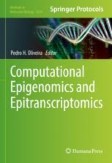Search
Search Results
-
Self-organizing maps with variable neighborhoods facilitate learning of chromatin accessibility signal shapes associated with regulatory elements
BackgroundAssigning chromatin states genome-wide (e.g. promoters, enhancers, etc.) is commonly performed to improve functional interpretation of...

-
eSPRESSO: topological clustering of single-cell transcriptomics data to reveal informative genes for spatio–temporal architectures of cells
BackgroundBioinformatics capability to analyze spatio–temporal dynamics of gene expression is essential in understanding animal development. Animal...

-
Comparative genomic analysis of the human genome and six bat genomes using unsupervised machine learning: Mb-level CpG and TFBS islands
BackgroundEmerging infectious disease-causing RNA viruses, such as the SARS-CoV-2 and Ebola viruses, are thought to rely on bats as natural reservoir...

-
Self-organization, quality control, and preclinical studies of human iPSC-derived retinal sheets for tissue-transplantation therapy
Three-dimensional retinal organoids (3D-retinas) are a promising graft source for transplantation therapy. We previously developed self-organizing...

-
Building 2D classification models and 3D CoMSIA models on small-molecule inhibitors of both wild-type and T790M/L858R double-mutant EGFR
AbstractEpidermal growth factor receptor (EGFR) has received widespread attention because it is an important target for anticancer drug design....

-
Classification models and SAR analysis on HDAC1 inhibitors using machine learning methods
Histone deacetylase (HDAC) 1, a member of the histone deacetylases family, plays a pivotal role in various tumors. In this study, we collected 7313...

-
Unsupervised explainable AI for molecular evolutionary study of forty thousand SARS-CoV-2 genomes
BackgroundUnsupervised AI (artificial intelligence) can obtain novel knowledge from big data without particular models or prior knowledge and is...

-
Topology preserving stratification of tissue neoplasticity using Deep Neural Maps and microRNA signatures
BackgroundAccurate cancer classification is essential for correct treatment selection and better prognostication. microRNAs (miRNAs) are small RNA...

-
Deep self-supervised machine learning algorithms with a novel feature elimination and selection approaches for blood test-based multi-dimensional health risks classification
BackgroundBlood test is extensively performed for screening, diagnoses and surveillance purposes. Although it is possible to automatically evaluate...

-
Analyzing high-dimensional cytometry data using FlowSOM
The dimensionality of cytometry data has strongly increased in the last decade, and in many situations the traditional manual downstream analysis...

-
Machine learning-based classification models for non-covalent Bruton’s tyrosine kinase inhibitors: predictive ability and interpretability
In this study, we built classification models using machine learning techniques to predict the bioactivity of non-covalent inhibitors of Bruton’s...

-
Classification of FLT3 inhibitors and SAR analysis by machine learning methods
FMS-like tyrosine kinase 3 (FLT3) is a type III receptor tyrosine kinase, which is an important target for anti-cancer therapy. In this work, we...

-
From pixels to connections: exploring in vitro neuron reconstruction software for network graph generation
Digital reconstruction has been instrumental in deciphering how in vitro neuron architecture shapes information flow. Emerging approaches reconstruct...

-
Predicting Chromatin Interactions from DNA Sequence Using DeepC
The genome 3D structure is central to understanding how disease-associated genetic variants in the noncoding genome regulate their target genes....
-
Next-Generation Sequencing in Medicinal Plants: Recent Progress, Opportunities, and Challenges
Medicinal plants have a significant role in human health care since the development of medicine. Plants that yield phytopharmaceuticals have produced...

-
Deciphering tissue structure and function using spatial transcriptomics
The rapid development of spatial transcriptomics (ST) techniques has allowed the measurement of transcriptional levels across many genes together...

-
Predicting moisture content in kiln dried timbers using machine learning
The uniformity of final moisture content within a drying timber batch is crucial. Lack of such uniformity leads to undesirable moisture ranges, thus...

-
Self-Organizing Map and Other Clustering Methods in Transcriptomics
Self-organizing map (SOM) is an artificial neural network algorithm, having been used frequently with transcriptomic data analysis, in particular for...
-
Mechanical Management of Modern Planar Fruit Tree Canopies
This chapter will discuss the opportunities and challenges of robotic solutions for tree fruit production with modern planar tree canopy management,...
-
Single-cell profiling of immune system alterations in lymphoid, barrier and solid tissues in aged mice
Aging exerts profound and paradoxical effects on the immune system, at once impairing proliferation, cytotoxicity and phagocytosis, and inducing...

